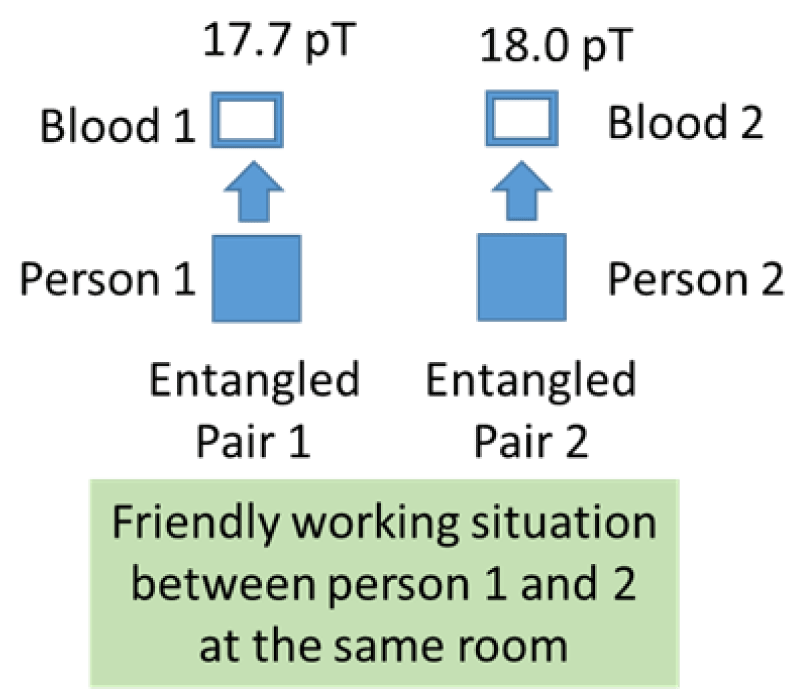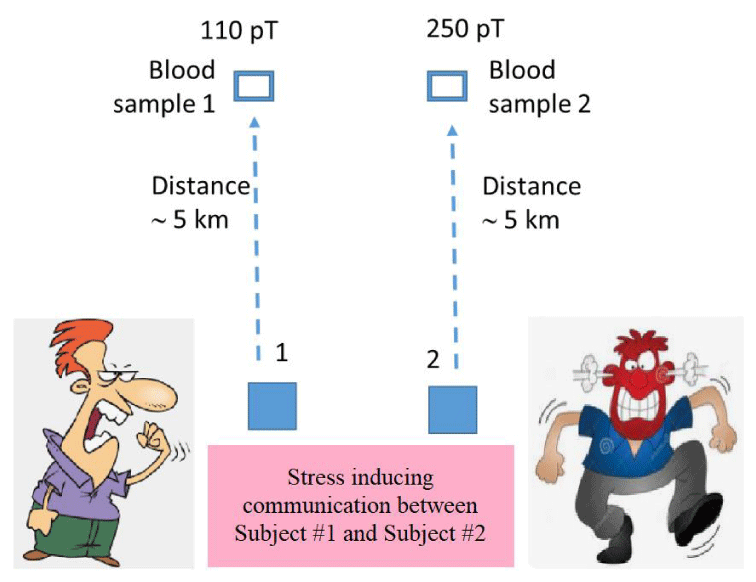Journal of Cardiovascular Medicine and Cardiology
Does “biological quantum entanglement” exists?
Djuro Koruga1*, Jadran Bandić2, Lidija Matija3, Spomenko Mihajlović4, Igor Koruga5 and Nikola Ilanković6
2ORS Hospital, 11000 Belgrade, Serbia,
3NanoLab, Biomedical Engineering, Faculty of Mechanical Engineering University of Belgrade, 11121 Belgrade Serbia,
4Geomagnetic Institute of Serbia, 11036 Brestovik, Grocka, Serbia
5ZEISS Group, Carl Zeiss Meditec, Inc., Dublin, CA 94568, USA
6Department of Neuropsychiatry and Neurophysiology, GH Medigroup, 11070 Belgrade, Serbia
Cite this as
Koruga D, Bandić J, Matija L, Mihajlović S, Koruga I, et al. (2022) Does “biological quantum entanglement” exists? J Cardiovasc Med Cardiol 9(4): 079-081. DOI: 10.17352/2455-2976.000190Copyright License
© 2022 Koruga D, et al. This is an open-access article distributed under the terms of the Creative Commons Attribution License, which permits unrestricted use, distribution, and reproduction in any medium, provided the original author and source are credited.In literature and clinical reports connections between a heart condition (blood properties) and emotional and mental states are documented [1,2]. It is well known that psychosocial risk factors may lead to the activation of mechanisms responsible for somatic dysfunction of the cardiovascular system. From this perspective, psychological and cardiac issues are not seen separately and there is a belief that a multidisciplinary approach, psychocardiology, is necessary for the well-being of the patient. The term psychocardiology is relatively new, but recognition of psychological influence factors to cardiovascular disease (CVD) has a long history [3].
We were curious to know what happens with blood’s magnetic activity in this sense: how long blood can be stored that can be used for biophysical investigation, or in other words how long in the blood can O2/Fe+2 complex in hemoglobin (Hb) be stable. In order to know blood’s diamagnetic and paramagnetic values one has to measure them. Oxygen itself is paramagnetic, as well as iron, but when they are joined in hemoglobin then complex O2/Fe2+ is diamagnetic [4]. By measuring the magnetic properties of blood we may obtain information about the oxygen/iron state, which has an influence on the molecular code of cooperativity in hemoglobin (HMCC) [5,6]. The functionality of HMCC is arguably responsible for the pathogenesis of disorders, such as cardiovascular disease nephropathy, retinopathy and some common diseases such as diabetes mellitus [7-9]. It is known that glycated hemoglobin (HbA1c) is used as a physiological measure of stress since it has a high correlation with some other psychological stress indicators. Also, stressful situations (environmental, social, mechanical injury, emotional, etc.) may have implications for the health of the cardiovascular system [7].
Our observational study comprised 12 volunteers, seven males and five females (aged between 30 and 60) who passed a general medical examination. Biochemical analyses of blood and general medical examination showed that all 12 voluntaries were healthy. In ORS Hospital, Belgrade, Serbia, a sample of 5.0 ml of venous blood was taken from each volunteer; 3.0 ml for biochemical analysis and 2.0 ml for experiment use. A sample with 3.0 ml of blood was stored in a standard test tube and transported to the biochemical laboratory, while a 2.0 ml blood sample was immediately stored in a specially designed plastic container for medical use and transported to the laboratory for magnetic measurement at the National Geomagnetic Institute, Belgrade, Serbia. Measurements were done using a JR-6 spinner magnetometer (AGICO, Czech Republic) with a measurement range from 3 pT to 16 mT, with ±1.5 pT accuracy. After initial sample measurements at room conditions (temperature 18 °C ±1 °C, humidity 32%±2%, Earth magnetic field 47 µT ± 0.010 µT, as well as electromagnetic smog < 3pT and with N-S defined directions), sample containers were stored in a separate isolated dark room, under control conditions. Immediately before the experiment started, the paramagnetic value of all twelve empty blood containers was measured, and then containers were filled with 2 ml collected blood samples, and paramagnetic values were then measured for each sample. For the next 25 days, daily measurements were made with the same measurement conditions, including time of the day and sample order. After 25 days the containers were emptied; the paramagnetism value of the empty containers ware measured for additional 7 days, in order to determine if the blood transferred magnetism to the container(s).
On the first day of measurement, the paramagnetic average value of the blood (all subjects), was in the range of 20.16 pT ± 3.50 pT. For the next 14 days, the blood paramagnetism values for all volunteers did not change significantly, however, on the 15th day, blood samples of two subjects showed very high values of paramagnetism - one subject (subject#1) had 110 pT, and the other subject (subject #2) 250 pT. This serendipity event immediately aroused our attention and we determined that on that day these two subjects had a heated discussion with a reported high degree of strong emotions and stress. Over the remaining ten days, the value of blood paramagnetism in the other 10 subjects remained within normal limits, while the values slightly decreased in the case of two subjects with heightened emotionally derived stress Figures 1,2.
For reference, subsequently, we continued and expanded the research and the number of healthy subjects increased by 64, for a total of 76. From a statistical point of view measured paramagnetic value of the blood of 78 people was stable. In the first cohort (12 people) paramagnetic value was 20.16 pT ± 3.5 pT, while for the second cohort (64 people) was 20.08 pT ± 3.56 pT.
In summary, we can say that our motivation for measuring the paramagnetism of human blood was to see how long blood can remain in a vital biophysical state at room temperature was successful. We observed the serendipity phenomenon (psychocardiological) at a distance (∼ 5 km), between two subjects and their 15-day-old blood sample. We called it “biological quantum entanglement” because not only do 3d-shell electronic states of the iron ion of the hemoglobin active center participate in a “strange” phenomenon [10], but also a very complex hemoglobin’s molecular code for cooperativity [5].
In Novosel [10] very important research with only 48 (oxy) and 46 (deoxy) atoms of hemoglobin hem was considered. According to this study the values of the local magnetic moment in spin state transitions of the active center in hemoglobin, from low-spin states to high-spin states, changed from 0.7 µB to 2.1 µB per hemoglobin molecule. However, hemoglobin is a very complex quantum nanomolecular machine, where the transition from ferrous heme ion (Fe+2) to ferric iron (Fe+3) plays a crucial role to orchestrate the free energy of 9272+2 (O2) atoms [C2952H4664N812O832S8Fe4] and generate hemoglobin molecular code of cooperativity. In normal situations, hemoglobin is in an oxy state of 95% while in a deoxy state is 5% (95/5). Since 5% of deoxy-hemoglobin in a normal situation gives a value of about 20 pT, while in a “strange” state gives 110 pT and 250 pT, it means that the oxy/deoxy state of hemoglobin could be 22/78 and 50/50, respectively. Since emotional stress changes the oxy/deoxy ratio of hemoglobin in the body, one possible explanation of the change in the sample could be that coupling structure - energy - information on the “bio-quantum dot” level (hemoglobin with about 9.000 atoms) generates quantum information between entangled pair on distance.
This communication is written based on the result of a serendipity event in the experiment and therefore requires further controlled research on a larger sample. However, this and similar experiments could open the possibility to extend the current research in quantum information science in physics and biology.
- Koch H. Psychocardiology: The spectrum of stress in the genesis of heart disease: a point of view, Research Reports in Clinical Cardiology. 2013; 4: 153-159.
- Halaris A. Psychocardiology: moving towards a new subspecialty. Future Cardiol. 2013; 9: 635-640.
- Kahl KG, Alvarenga ME, Byrne D. Psychocardiology: Exploring the Brain-Heart Interface. Lausanne: Frontiers Media SA. 2022. doi: 10.3389/978-2-83250-058-3,
- Holt RIG, Cockkram CS, Flyvbjerg A. Goldstein. Textbook of Diabetes, Wiley-Blackwell, Chichester, UK, 2010.
- Mathews KC, van Holde EK, Biochemistry. The Benjamin/Cummings Publishing Company, Inc., Redwood City 1990.
- Ackers GK, Doyle ML, Myers D, Daugherty MA. Molecular Code for Cooprativity in Hemoglobin. Science. 1992; 255: 54-62.
- Schuck P. Glycated hemoglobin as a physiological measure of stress and its relations to some psychological stress indicators. Behav Med. 1998 Summer;24(2):89-94. doi: 10.1080/08964289809596386. PMID: 9695900.
- Phillips AC. Stress and Cardiovascular Reactivity. In: Alvarenga, M., Byrne, D. (eds) Handbook of Psychocardiology. Springer, Singapore. 2016. https://doi.org/10.1007/978-981-287-206-7_16
- Holt RIG, Cockkram CS, Flyvbjerg A. Goldstein, Textbook of Diabetes, Wiley-Blackwell, Chichester, UK, 2010.
- Novoselov D, Korotin DM, Anisimov VI. Quantum states entanglement in hemoglobin molecule active center. arXiv:1602.02963v2 [cond-mat. str-el] 17 Feb 2016.

Article Alerts
Subscribe to our articles alerts and stay tuned.
 This work is licensed under a Creative Commons Attribution 4.0 International License.
This work is licensed under a Creative Commons Attribution 4.0 International License.



 Save to Mendeley
Save to Mendeley
